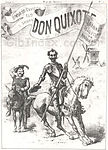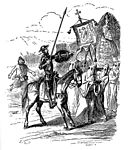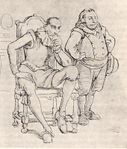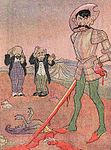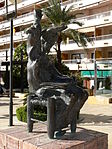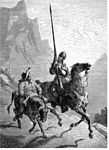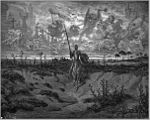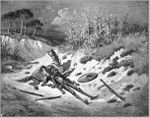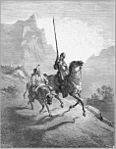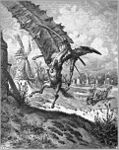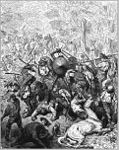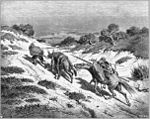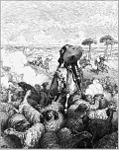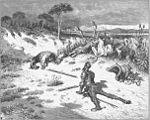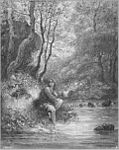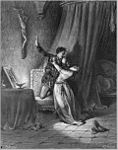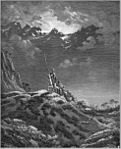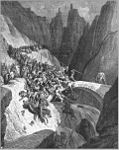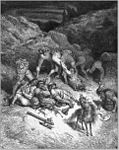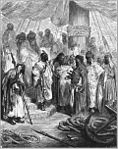- List of works influenced by Don Quixote
-
The novel Don Quixote (Spanish:
 Don Quijote (help·info); English: /ˌdɒn kiːˈhoʊtiː/, fully titled The Ingenious Hidalgo Don Quixote of La Mancha (Spanish: El ingenioso hidalgo don Quijote de la Mancha), was written by Spanish author Miguel de Cervantes. Published in two volumes a decade apart (in 1605 and 1615), Don Quixote is one of the most influential works of literature from the Spanish Golden Age in the Spanish literary canon. As a founding work of modern Western literature, it regularly appears high on lists of the greatest works of fiction ever published.[1] It has been the inspiration for a wide array of cultural adaptations.
Don Quijote (help·info); English: /ˌdɒn kiːˈhoʊtiː/, fully titled The Ingenious Hidalgo Don Quixote of La Mancha (Spanish: El ingenioso hidalgo don Quijote de la Mancha), was written by Spanish author Miguel de Cervantes. Published in two volumes a decade apart (in 1605 and 1615), Don Quixote is one of the most influential works of literature from the Spanish Golden Age in the Spanish literary canon. As a founding work of modern Western literature, it regularly appears high on lists of the greatest works of fiction ever published.[1] It has been the inspiration for a wide array of cultural adaptations.Contents
Influence on literature
Drama
- 1612 The Knight of the Burning Pestle by Francis Beaumont has been described as "the first English imitation of Don Quixote".[2]
- 1613 Cardenio, a lost Shakespearean play, is believed to be based on an episode in Part One of Don Quixote.[3]
- 1694 The Comical History of Don Quixote is a comic play by Thomas D'Urfey with music and songs by composers including Henry Purcell. The play was written in three parts, adding up to more than seven hours of playing time. It is seldom if ever performed today, and never at its full length.
- 1734 Don Quixote in England by Henry Fielding was written in 1728 as an attack on Prime Minister Robert Walpole.[4]
- 1785–1787 Don Chisciotti e Sanciu Panza by Giovanni Meli is a Sicilian parody of Don Quixote.
- 1953 Camino Real by Tennessee Williams features a cast of classic literary characters that includes Don Quixote and Sancho Panza.
Novels and other literature
- 1742 Joseph Andrews by Henry Fielding notes on the title page that it is "written in Imitation of the Manner of Cervantes, Author of Don Quixote".
- 1752 The Female Quixote (1752), a novel by Charlotte Lennox.
- 1759–1767 The Life and Opinions of Tristram Shandy, Gentleman by Laurence Sterne was influenced by Cervantes' novel in several ways, including its genre-defying structure and the Don Quixote-like character of Uncle Toby. Intentional nods include Sterne's own description of his characters' "Cervantic humour" and naming Parson Yorick's horse 'Rocinante'.
- 1760-1762 The Life and Adventures of Sir Launcelot Greaves by Tobias Smollett. Smollett shows the influence of Don Quixote in many of his novels (e.g. the character of Lismahago in Humphry Clinker), but this is his "own explicit version of the D[on] Q[uixote] story." Smollett had also produced his own translation of Don Quixote in 1755.[5]
- 1773 The Spiritual Quixote by Richard Graves is a satire on Methodism.
- 1856 Madame Bovary by Gustave Flaubert was heavily influenced by Don Quixote.[6] In the view of the critic Howard Mancing, "of all the many female incarnations of Don Quixote, Emma [Bovary] is the most original, profound and influential. Flaubert's admiration for Cervantes knew no bounds. It has been suggested that it was his reading of Don Quixote in childhood which convinced Flaubert to become a novelist rather than a dramatist." In Madame Bovary, the heroine, like Don Quixote, tries to escape from the tedium of provincial life through books, in Bovary's case women's romances and historical novels.[7]
- 1869 The Idiot by Dostoyevsky. Prince Myshkin, the title character of the novel, was explicitly modeled on Don Quixote.[8]
- 19?? "The Truth About Sancho Panza" by Franz Kafka imagines Sancho as Author
- 1927 The Return of Don Quixote by G. K. Chesterton tells the tale of the librarian Michael Herne, who, after performing as the lead actor in a medieval theater play, finds reality unacceptable and decides to roam the country in the fashion of Don Quixote.
- 1939 "Pierre Menard, Author of the Quixote" by Jorge Luis Borges is a short story about a fictional 20th-century writer who re-authors Don Quixote. According to the story, "The text of Cervantes and that of Menard are verbally identical, but the second is almost infinitely richer."
- 1960 The Art of the Novel by Milan Kundera extensively references and extols Cervantes' Don Quixote as the first, and perhaps best, novel. Kundera writes that his own novels are an homage to Cervantes.
- 1966 The Order of Things by Michel Foucault. Quixote's confusion in Cervantes' novel plays an important part in Foucault's book, serving as an illustration of the transition to a new configuration of thought in the late sixteenth century.
- 1982 Monsignor Quixote by Graham Greene is a pastiche of Cervantes' novel. Greene's character Monsignor Quixote regards himself as a descendant of Don Quixote.
- 1985 "City of Glass (Paul Auster book)" in "The New York Trilogy" by Paul Auster. In this postmodern detective story, the protagonist, Daniel Quinn, is modeled after Don Quixote. The novella includes an explicit discussion of Don Quixote's authorship.
- 1986 Don Quixote: Which Was a Dream, a novel by Kathy Acker, revisits the themes of Cervantes' text to highlight contemporary issues.
- 1995 The Moor's Last Sigh by Salman Rushdie, with its central themes of the world being remade and reinterpreted, draws inspiration (as well as names and characters) from Cervantes's work.
- 1998 Yo-Yo Boing!, a Spanglish comic novel by Giannina Braschi, features conversations between Don Quijote, Sancho Panza, and Dulcinea, who have been transported into 20th-century New York.
- 2009 The Shadow Dragons, the fourth novel in James A. Owen's series The Chronicles of the Imaginarium Geographica, features Don Quixote as one of its major characters.
Music, opera and ballet
- 1743 (premiere) Don Quichotte chez la Duchesse, a short ballet by Joseph Bodin de Boismortier, was loosely adapted from the novel's chapters dealing with the frivolous Duke and Duchess, who play practical jokes on Quixote.
- 1761 Don Quichotte auf der Hochzeit des Camacho, an opera by Georg Philipp Telemann, was based on an episode from the novel.
- 1767 Don Quichotte orchestral suite by Georg Philipp Telemann
- 1827 Die Hochzeit des Camacho is an early opera by Felix Mendelssohn based on the same section of the book on which Telemann based his opera.
- 1861 Don Quijote, a zarzuela by Francisco Asenjo Barbieri, had its premiere on 23 April 1861, the anniversary of Cervantes' death.
- 1869 "Combate de Don Quijote contra las Ovejas" is a scherzo for orchestra by the Spanish composer Ruperto Chapí.
- 1869 Ludwig Minkus composed the music for Marius Petipa's ballet Don Quixote, which was staged for the Bolshoi Theatre in Moscow in 1869, and was revised in more elaborate production for the Imperial Ballet of St. Petersburg in 1871. The libretto was based on the same chapters in the novel which attracted Mendelssohn and Telemann. Petipa's ballet was substantially revised by Alexander Gorsky in 1900 for the Bolshoi Theatre in Moscow, a version which was staged for the Imperial in 1902. Gorsky's 1902 staging was revisited by several other choreographers in the twentieth century in Soviet Russia, and has since been staged by ballet companies all over the world. In 1972, Rudolf Nureyev filmed his version of the ballet with the Australian Ballet.
- 1874 (premiere) Don Quichotte, a play by Victorien Sardou with incidental music by Jacques Offenbach.
- 1898 (premiere) Don Quixote, a tone poem by Richard Strauss (subtitled "Fantastic Variations for Large Orchestra on a Theme of Knightly Character"). The music makes explicit reference to several episodes in the novel, including the sheep (described by flutter-tongued brass) and windmill episodes.
- 1910 (premiere) Don Quichotte by Jules Massenet at Monte Carlo Opera with operatic basso Feodor Chaliapin. When director G.W. Pabst made a semi-musical film in 1933 with a score by Jacques Ibert, he chose Chaliapin to play Don Quixote.
- 1923 (premiere) Master Peter's Puppet Show, a puppet opera by Manuel de Falla, is based on an episode from Book II and was first performed at the Salon of the Princess de Polignac in Paris.
- 1932-4 Don Quichotte à Dulcinée ("Don Quixote to Dulcinea") by Maurice Ravel, three songs for voice and piano set to Quixote poems by Paul Morand (composed in 1932 and orchestrated in 1934).
- 1940–41, Don Quixote, ballet by Catalan composer Roberto Gerhard. The ballet became the source for a number of orchestral suites and Gerhard also used it in the incidental music he provided for a BBC radio adaptation of Cervantes’s novel by Eric Linklater, The Adventures of Don Quixote (1940). Gerhard re-wrote the ballet in 1947–49 and it was staged by Sadler's Wells Ballet at Covent Garden with choreography by Ninette de Valois and décor by Edward Burra.
- 1960 Don Quixote, symphony by the Azerbaijani composer Gara Garayev
- 1965 Don Quixote, a ballet by George Balanchine, with music by Nicolas Nabokov, dedicated to and starring Suzanne Farrell.
- 1965 Man of La Mancha, a full-length Broadway musical with music by Mitch Leigh, lyrics by Joe Darion and based on Dale Wasserman's non-musical teleplay I, Don Quixote. Written to be performed without intermission, the musical combines episodes from the novel with a story about Miguel de Cervantes, as a play within a play. It premiered in 1965 and was filmed in 1972. It featured the song "The Impossible Dream", which was subsequently recorded by many artists.
- 1982-3 Don Quixote and Sancho Panza (subtitled A Bagatelle Cycle), a work for two guitars by British composer Ronald Stevenson consisting of a double theme with seventeen variations, based on various events in Cervantes' novel. The work premiered in Glasgow in 1998.
- 1985 "Don Quixote", a song by Nik Kershaw
- 1994 Dulcinea is an album by Toad the Wet Sprocket, whose title is a reference to Quixote's love interest in Cervantes' novel. The lyrics of two songs on the album, "Crowing" and "Windmills", allude to elements from the novel.
- 1998 La Leyenda de la Mancha, a concept album by the Spanish group Mägo de Oz ("Wizard of Oz"), is a modern retelling of the story of Don Quixote.
- 2002 "Don Quixote", a rap song based on the story from the album Chicano Blues by the Funky Aztecs.
- 2010 "Don Quixote (Spanish Rain)", a song by British band Coldplay, premiered during their 2010 Latin American tour. The song's lyrics refer to elements from the novel.
Selected film adaptations
- 1906 Don Quixote, a French short directed by Lucien Nonquet.
- 1911 Don Chisciotte, an Italian short.[9]
- 1915 Don Quixote, a silent US film starring DeWolf Hopper, directed by Edward Dillion.[9]
- 1926 Don Quixote a silent Spanish-Danish co-production directed by Lau Lauritzen Sr., starring Danish comedians (Carl Schenstrøm and Harald Madsen).[9]
- 1933 Adventures of Don Quixote directed by Georg Wilhelm Pabst, with music composed by Jacques Ibert. This version was made three times in the same year, and in three different languages: French, English and German. All three versions used the same script, set designs, and costumes, and all three starred the great Russian bass Feodor Chaliapin.
- 1934 Don Quixote directed by Ub Iwerks and published as a Comicolor cartoon, is an animated cartoon loosely based on the novel.
- 1947 Don Quijote de la Mancha, the first full-length Spanish film version of the novel, directed by Rafael Gil.[9]
- 1957 Don Quixote, Soviet film directed by Grigori Kozintsev, music by Gara Garayev and starring Nikolay Cherkasov, the first live-action version in color.
- 1965 Don Quijote, a French/German made-for-television miniseries in four parts. It was directed by Carlo Rim and starred Josef Meinrad.
- 1965 Don Quichotte de Cervantes, a 23-minute French film by Éric Rohmer.[10]
- 1971 They Might Be Giants, a 1971 film based on the play of the same name (both written by James Goldman), whose title is a reference to Don Quixote's exploit of tilting at windmills, believing them to be giants. The two lead characters have a relationship similar to Quixote and Panza, with one appearing delusional and the other seeing reality clearly but following the "visionary" out of concern and friendship.
- 1972 Man of La Mancha, directed by Arthur Hiller, is a film version of the stage musical by Dale Wasserman, with music by Mitch Leigh and lyrics by Joe Darion). The film version starred Peter O'Toole, Sophia Loren and James Coco. The stage musical was based on Wasserman's 1959 non-musical television play, I, Don Quixote, which combines a semi-fictional episode from the life of Cervantes with scenes from his novel.
- 1973 Don Quijote cabalga de nuevo. Mexican/Spanish, directed by Roberto Gavaldón, starring Cantinflas and Fernando Fernán Gómez.
- 1973 The Adventures of Don Quixote, a British made-for-television film starring Rex Harrison and Frank Finlay, directed by Alvin Rakoff, with a script by Hugh Whitemore. It was first telecast on the anthology series Play of the Month, and was later shown as a television special in the U.S.
- 1973 Don Quixote a film version of the Minkus ballet, starring Rudolf Nureyev, Lucette Aldous, Robert Helpmann and artists of the Australian Ballet.
- 1980 Don Quixote: Tales of La Mancha, a Japanese anime series produced by Ashi Productions and distributed by Toei Animation.[11]
- 1988 Life of Don Quixote and Sancho, a nine-episode series filmed in Georgia and Spain by Georgian director Rezo Chkheidze.
- 1991 Monsignor Quixote, a television film of Graham Greene's 1982 novel, directed by Rodney Greene, starring Alec Guinness, Leo McKern, Ian Richardson and Rosalie Crutchley.
- 1991 El Quijote de Miguel de Cervantes, a television miniseries of Part I of the novel, directed by Manuel Gutiérrez Aragón, scripted by Camilo José Cela and starring Fernando Rey and Alfredo Landa. The project of a second miniseries including Part II was stopped because of Rey's death.
- 1992 (released) Don Quixote (unfinished). Begun by Orson Welles; a reshaped version by Jesus Franco was released in 1992.
- 2000 Don Quixote, a US TV film directed by Peter Yates, co-produced by Hallmark Channel and Turner Network Television, starring John Lithgow, Bob Hoskins, Vanessa L. Williams, and Isabella Rossellini. Script was by John Mortimer.
- 2002 Lost in La Mancha, a documentary film about Terry Gilliam's failed first attempt to make a film adaptation of Don Quixote.
- 2002 El Caballero Don Quijote, Manuel Gutiérrez Aragón's two-hour theatrical film based on Part II of the novel. This belated sequel to Aragón's 1991 miniseries starred a completely different cast, including Juan Luis Galiardo as Quixote.
- 2007 Donkey Xote, a Spanish CG-animated film that re-envisions the book with Sancho's donkey Xote as the lead character.
- 2011 The Man Who Killed Don Quixote, an upcoming Terry Gilliam adaptation.[12]
Paintings and illustrations
Don Quixote has inspired many illustrators, painters and sculptors, including Gustave Doré, Pablo Picasso, Salvador Dalí and Antonio de la Gandara. The French artist Honoré Daumier produced 29 paintings and 49 drawings based on the book and characters of Don Quixote, starting with an exhibition at the 1850 Paris Salon, which would later inspire Pablo Picasso. In 1863, Gustave Doré produced a large set of drawings based on Don Quixote. On 10 August 1955, Pablo Picasso drew an illustration of Don Quixote and Sancho Panza for the journal weekly Les Lettres françaises (week of 18–24 August 1955), which quoted from the Daumier caricature of a century before. Widely reproduced, today it is the iconic image used by the Spanish government to promote Cervantes and Don Quixote.
-
Don Quixote and Sancho Panza by Honoré Daumier. Black crayon and wash. The Metropolitan Museum of Art. New York (c. 1850)
-
By Honoré Daumier (1868)
-
By Angelo Agostini (1885)
-
Don Quixote is knighted by the inn-keeper from The Book of Knowledge, The Grolier Club, (1911)
-
Emiliano Zapata depicted as Don Quixote. From La Risa, 1911
-
Feodor Chaliapin as Quixote by Alexandre Jacovleff, 1916
-
Don Quixote by Salvador Dalí
Illustrations by Gustave Doré, originally published 1863
See also
References
- ^ "The top 100 books of all time". The Guardian (London). 8 May 2002. http://books.guardian.co.uk/news/articles/0,6109,711520,00.html. Retrieved 1 May 2010. "Don Quixote gets authors' votes". BBC News. 7 May 2002. http://news.bbc.co.uk/2/hi/entertainment/1972609.stm. Retrieved 3 September 2010.
- ^ Ardila
- ^ Ardila p.6
- ^ Brean Hammond in Ardila, p. 97
- ^ Cervantes Encyclopedia L-Z p.682
- ^ http://www.sussex-academic.co.uk/sa/titles/literary_criticism/Fox.htm
- ^ Cervantes Encyclopedia A-K p.140
- ^ Penguin Classics: Features
- ^ a b c d Sadoul, Georges and Peter, Morris Dictionary of films University of California Press p. 91 ISBN 0520021525
- ^ Películas sobre Don Quijote - Quixote Films (Spanish)
- ^ "Don Quixote – Tales of La Mancha @ Toonarific Cartoons". http://www.toonarific.com/show.php?show_id=856.
- ^ The Man Who Killed Don Quixote (2011) at the Internet Movie Database
Sources
- The Cervantean Heritage: Reception and Influence of Cervantes in Britain ed. J.A. Ardila (MHRA, 2009)
- Howard Mancing The Cervantes Encyclopedia L-Z (Greenwood, 2004)
Further reading
- Bloom, Harold (Ed.) (2000) Cervantes's Don Quixote (Modern Critical Interpretations). Chelsea House Publishers ISBN 0791059227
- D' Haen, Theo (Ed.) (2009) International Don Quixote. Editions Rodopi B.V. ISBN 9042025832
- Echevarría, Roberto González (Ed.) (2005) Cervantes' Don Quixote: a casebook Oxford University Press USA ISBN 0195169387
- Duran, Manuel and Rogg, Fay R. (2006) "Fighting Windmills: Encounters with Don Quixote". Yale University Press ISBN 9780300110227
- Johnson, Carroll B (Ed.) (2006) Don Quijote Across Four Centuries: 1605-2005. Juan de la Cuesta-Hispanic Monographs ISBN 1588710882
External links
- Don Quixote on In Our Time at the BBC. (listen now)
- "One Master, Many Cervantes", by Ilan Stavans. A history of English translations. Humanities, September/October 2008. Volume 29, Number 5. Accessed 2010-08-04
- Works by Cervantes at Project Gutenberg
Categories:
Wikimedia Foundation. 2010.



